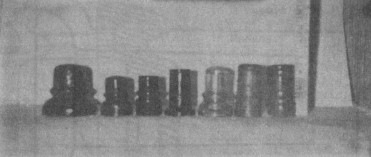Baby Canadian Threadless
by Jack Hayes
Reprinted from "INSULATORS - Crown Jewels of the Wire", April 1976, page 12
In his article on the Battleford Baby in Insulators, September 1972, Ren
Settle, now of Ottawa, brought to our attention "that reduction in weight
was a prime consideration when the line materials were ordered" for the
first telegraph line in western Canada, because great distances had to be
covered. The same reasoning no doubt prevailed in the design of the McMicking
for the British Columbia line, which required transportation of materials up the
mountainous Frazer Canyon to Quesnel and beyond. (The Williams Lake, B.C. museum
has a McMicking that came from the line.) Surprisingly enough, four more small
insulators have been found in Canada, all in Ontario. At first, I would have
considered distance and difficulty of transportation as a less important factor
in the design of Ontario insulators. However, on reading of the problems of
early transportation in Ontario, through swamps and forest, I now consider the
weight factor to be of considerable importance. The durability factor I am sure
was soon recognized, as these small insulators were replaced in short order with
larger types.
The newest small Canadian insulator discoveries include a black glass
smooth-sided Wade type of the same size as a CD 721, with a skirt similar to the
CD 724.5. It measures 3-1/8" high, 1-3/8" diameter, with a 2"
diameter skirt. The other new discovery is a black glass flat top straight-sided
baby similar to the Battleford, but of much straighter lines and without a
skirt, making it more durable. Perhaps the drawing and picture enclosed (see
following pages) can better describe these insulators.

 |
|
Left to right: Foster Bros., Battleford Baby, New Type, New Type Wade,
McMicking, 721 Wade, 721 Wade. |
The other new small Canadians to which I refer, that have been discovered
since the Battleford article, are the two CD 721 Wades shown on page 322 of
Milholland's 3rd Revision, and which I discussed in my May 1975 article in
Insulators as having been made at the Canada Glass Company's Works at Hudson,
Quebec. Money must certainly have been an important factor in Canada in those
days when roads charged tolls and railways had difficulties in reaching their
objectives for lack of funds. Thus the factors of design that were undoubtedly a
lineman's nightmare in the early days, are the factors that have given us the
baby threadless.
The history of the Canadian telegraph and its precious jewels is beginning to
unravel, but we sure have a long way to go with new items showing up each year.
The threadless porcelain with a 1-5/8" pinhole, reported in November 1975 Insulators, is another mystery to track down. One of this same type was shown on
a local TV show, "The Joy of Collecting", early in January 1976. I
believe there are two known to date -- the one that Ren Settle showed on TV, and
the one reported by Douglas Henderson (Hawesbury, Ontario).
I have mentioned in previous articles that I have enjoyed the help of other
collectors such as Bill Bagg of Ottawa, whom I believe has the best collection
of Canadian threadless, and Mr. Burt Carter of Innerkip, Ontario, whose
discoveries were mentioned in Insulators, October 1975. Another who has
furthered the collecting of threadless in Canada is Norman Banks of Princeton,
Ontario (519-458-4536).
As we are now locked in winter in Canada and the northern U.S., we can make
great gains by hitting the books, as Ren Settle advised in his article of
September 1972 on finding the Battlefords. Digging up a new piece of historical
information is almost as exciting as digging up a new piece of glass!
|
